Panasonic AG-AF100P User Manual
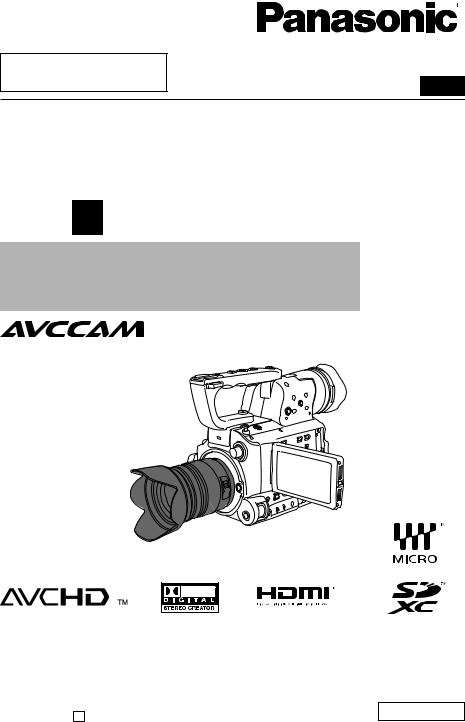
 This product is eligible for the AVCCAM 3 Year Warranty Repair Program. For details, see page 5 of vol.1.
This product is eligible for the AVCCAM 3 Year Warranty Repair Program. For details, see page 5 of vol.1.
Operating Instructions Vol.2
Memory Card Camera-Recorder
Model No. AG-AF100P
Volume 2
Note that Operation Instructions Vol.2 describes advanced operations of the Memory Card Camera-Recorder.
For instructions on basic operations of the Memory Card CameraRecorder, refer to Operating Instructions Vol.1 (printed documents) contained in the supplied CD-ROM.
Before operating this product, please read the instructions carefully and save this manual for future use.
M1210AT0 -FJ D
ENGLISH
Printed in Japan |
VQT3M18A (E) |

Contents
|
Volume 1 |
|
|
|
|
Read this first! |
Attaching/detaching the grip |
|
IMPORTANT SAFETY INSTRUCTIONS |
The remote control |
|
Recommendation for Use of Genuine |
Turn on/off the camera |
|
Panasonic Battery |
Tally lamp |
|
Outline of operations |
Viewfinder |
|
Please read before use |
Setting the calendar |
|
Operating precautions |
Shooting |
|
Before use |
||
Basic shooting operations |
||
|
||
Precaution for use |
Basic operations of the camera |
|
Accessories |
Menu |
|
Optional accessories |
||
Description of parts |
Using the setup menus |
|
Description of parts |
Setup menu structure |
|
Reference |
||
Preparation |
||
Specifications |
||
Recharging the battery |
||
|
||
Power sources |
|
|
Adjusting the hand strap |
|
|
Attaching/detaching the handle |
|
|
|
|
|
|
|
|
|
Volume 2 |
|
|
|
Shooting |
|
Shooting in progressive mode...................... |
4 |
Shooting techniques for different targets.... |
5 |
Self-portrait shooting ......................................... |
5 |
Zebra pattern .................................................... |
5 |
Marker................................................................ |
6 |
Checking and displaying shooting status........... |
6 |
PRE REC........................................................... |
6 |
Relay function.................................................... |
6 |
Variable frame rate (VFR).................................. |
7 |
Shooting using the FUNCTION knob............... |
10 |
Optical Image Stabilizer................................... |
11 |
Adding effects to images.................................. |
11 |
Using the USER buttons ................................. |
11 |
Backlight compensation................................... |
11 |
Color bars........................................................ |
11 |
Wave form monitor function............................. |
12 |
Adjusting the volume while shooting................ |
12 |
Shot mark function........................................... |
13 |
Index recording................................................ |
13 |
LAST CLIP function.......................................... |
13 |
CAPTURE function.......................................... |
13 |
Adjusting the shutter speed......................... |
14 |
Using the SHUTR/F.RATE dial......................... |
14 |
Setting the SHUTTER...................................... |
14 |
Setting the SYNCRO SCAN............................ |
14 |
FRAME RATE setting....................................... |
14 |
Synchro scan................................................... |
16 |
Switching Audio Input.................................. |
17 |
Using the built-in microphone.......................... |
17 |
Using an external microphone and audio |
|
equipment.................................................... |
17 |
Adjusting the recording level............................ |
18 |
Using scene files........................................... |
19 |
Changing scene file settings............................ |
19 |
Saving scene files and other settings on SD |
|
Memory Cards......................................... |
21 |
Clip metadata................................................. |
22 |
Uploading the metadata (META DATA)............ |
23 |
Selecting the USER CLIP NAME |
|
recording method......................................... |
23 |
Using the Counter......................................... |
24 |
Counter display................................................ |
24 |
TC preset mode............................................... |
24 |
2

Charging the built-in battery/ |
|
Setting the time code............................ |
25 |
Recharging the built-in battery......................... |
25 |
Setting the time code....................................... |
25 |
Specifying the time code (TC PRESET).......... |
25 |
Setting user information................................... |
27 |
Playback |
|
Basic playback operations........................... |
28 |
Thumbnail screen......................................... |
29 |
Basic thumbnail screen operations.................. |
29 |
Adding shot marks to clips............................... |
31 |
Select the card slot for playback...................... |
31 |
Playback settings (PLAY SETUP)................ |
32 |
Set playback format (PB FORMAT)................. |
32 |
Repeat playback (REPEAT PLAY)................... |
32 |
Resume playback (RESUME PLAY)................ |
33 |
Set skip method (SKIP MODE)........................ |
33 |
Thumbnail operations................................... |
34 |
Selecting the thumbnail display method |
|
(THUMBNAIL).............................................. |
34 |
Deleting and protecting clips (OPERATION).... |
35 |
Copying clips (COPY)...................................... |
36 |
Format card and check clip and |
|
card information (CARD FUNCTIONS)........ |
37 |
Useful playback functions............................ |
39 |
Fast forward/rewind......................................... |
39 |
Next/previous clip............................................. |
39 |
Frame-by-frame playback................................ |
40 |
Adjust volume.................................................. |
40 |
Viewing images on a television........................ |
40 |
Checking the date and time............................. |
40 |
Editing |
|
Connecting external units............................ |
41 |
Headphones..................................................... |
41 |
External microphone........................................ |
41 |
Computer (non-linear editing/file transfer)....... |
42 |
TV/Monitor....................................................... |
42 |
Nonlinear editing........................................... |
44 |
Menu |
|
Setup menu list............................................. |
51 |
SCENE FILE screen........................................ |
51 |
SW MODE screen............................................ |
53 |
RECORDING SETUP screen.......................... |
56 |
TC/UB SETUP screen...................................... |
57 |
AV IN/OUT SETUP screen............................... |
58 |
DISPLAY SETUP screen................................. |
59 |
CARD FUNCTIONS screen............................. |
61 |
USER FILE screen........................................... |
61 |
META DATA screen.......................................... |
62 |
OTHER FUNCTIONS screen........................... |
62 |
PLAY SETUP screen....................................... |
64 |
THUMBNAIL screen......................................... |
65 |
OPERATION screen........................................ |
65 |
Reference |
|
Before calling for service............................. |
66 |
Updating the firmware |
|
incorporated into the unit..................... |
70 |
Cleaning......................................................... |
71 |
Storage Precautions..................................... |
72 |
How to handle data recorded on |
|
SD Memory Card.................................... |
73 |
Displays |
|
Screen displays............................................. |
45 |
Regular displays.............................................. |
45 |
Main warning displays...................................... |
48 |
Setting the DISPLAY items.............................. |
50 |
3

Shooting in progressive mode
Selecting 1080/30P or 1080/24P in the REC FORMAT option (Page 51) of the setting menu SCENE FILE screen enables shooting in progressive mode.
30P mode:
Shoot 30 frames a second in the progressive mode.
For output and recording, the 30-frame-per- second signal is converted to 60-field-per-second interlace.
This mode gives you high quality images.
30 P A B C D E F G H I J
60 i AoAeBoBeCoCeDoDeEoEeFoFeGoGeHoHe Io Ie Jo Je
24P mode:
Shoot 24 frames a second in the progressive mode.
The video signal will be recorded natively. However, the external output signal is converted to a 2:3 format, 60 fps interlaced signal.
24 P A B C D E F G H
60 i AoAeBoBeBoCeCoDeDoDeEoEeFoFeFoGe GoHeHo He
25P mode:
Shoots 25 frames a second in the progressive mode.
For output and recording of video signal, the 25-frame-per-second image is converted to 50-field-per-second interlace signal.
This mode gives high quality images.
25 P A B C D E F G H I J
50 i AoAeBoBeCoCeDoDeEoEeFoFeGoGeHoHe Io Ie Jo Je
Note the following when shooting in progressive mode.
•Set the shutter speed to 1/50 (OFF) for best results.
•There may be a slight delay to the start of recording when you use the 24P mode because 4 frames are recorded at a time.
4

Shooting techniques for different targets
Self-portrait shooting
Images in the LCD monitor when it is turned 180° for self-portrait shooting may appear unusual. You can make them appear better by reversing left and right. Go to the setup menus, DISPLAY SETUP screen, SELF SHOOT, and select
MIRROR. Shooting in mirror mode has no effect on what you actually shoot and record.
•Images played back by pressing the REC CHECK button cannot be inverted horizontally.
•Operation status displays during self-portrait recording
No display: Cannot record (no card, etc.)
 : Recording in progress, during transition to the recording pause mode
: Recording in progress, during transition to the recording pause mode



 : Recording paused (recording standby)
: Recording paused (recording standby)
 : Warning display
: Warning display
•Only part of the screen display appears.
When [  ] is displayed, turn the LCD monitor back in the direction of normal recording, and check what the message says.
] is displayed, turn the LCD monitor back in the direction of normal recording, and check what the message says.
•To confirm screen display information on the viewfinder, turn the LCD monitor to the normal shooting position.
Zebra pattern |
|
|
|
Shooting |
|||
Press the ZEBRA button in the CAM mode to show |
|||
|
|||
the zebra pattern or marker on the viewfinder and |
|
||
the LCD monitor so you can check the brightness |
|
||
of the subject. |
|
||
|
|||
Parts that may be whited out through over |
|
||
exposure are shown as a zebra pattern. |
|
||
• Very bright |
|
||
• Reflecting parts |
|
||
ZEBRA button |
|
||
BARS |
ZEBRA |
|
OIS |
EVF DTL |
CH1 SEL |
CH2 SEL |
|
|
INT(L) |
INPUT1 |
|
|
INPUT1 |
INPUT2 |
|
|
INPUT2 |
|
|
WFM |
AUDIO |
||
|
INPUT1 |
INPUT2 |
|
|
ON |
|
ON |
COUNTER-RESET/TC SET |
OFF |
|
OFF |
|
MIC POWER +48V |
||
You can remove most overexposed parts by adjusting the iris and shutter speed in the manual mode to remove the areas with zebra patterns. The display changes as follows each time you press the ZEBRA button.
ZEBRA 1 → ZEBRA 2
↑↓
ZEBRA OFF ← MARKER ON
In the setup menus, DISPLAY SETUP screen, ZEBRA DETECT1 and ZEBRA DETECT2, set the brightness for the zebra patterns. (Page 59)
If the ZEBRA DETECT2 item is set to OFF, ZEBRA2 will not be displayed even if the ZEBRA button is pressed.
The zebra pattern you have set appears as a percentage on the display for about 2 seconds.
The zebra pattern is displayed in the color bar as well.
5
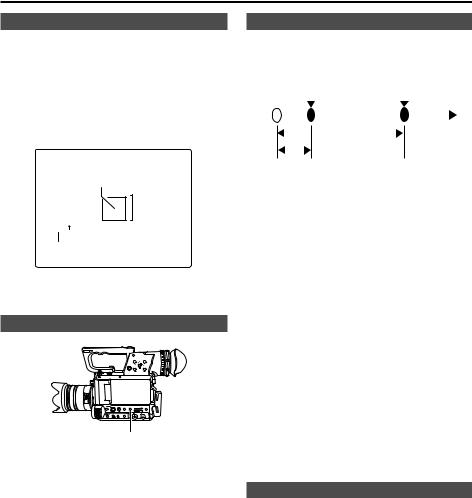
Shooting techniques for different targets (continued)
Marker
If you press the ZEBRA button while the zebra pattern is being displayed, a marker appears in the center of the display (if you have set the setup menu, DISPLAY SETUP, MARKER to ON).
The brightness of the areas near the screen center can be checked as a percentage (0% to 99%).
“99%↑” appears if the percentage is over 99.
Image level detection area
Marker
99%
Image level
The normal display reappears if you press the ZEBRA button again.
Checking and displaying shooting status
|
|
START/ |
|
PUSH-ENTER |
|
|
STOP 2 |
|
|
|
|
|
– |
+ |
FOCUS FUNCTION |
USER 1 |
DISP/ |
POWER.. |
|
MODECHK |
MODE |
|||
IRIS GAIN WHITEBAL |
USER 2 |
|
AUDIOLEVEL |
|
DISP/MODE CHK button
Pressing the DISP/MODE CHK button during recording or while recording is paused will remove all displays from the screen except the operation status display, frame display (such as area), counter, marker, and safety zone display.
Pressing the DISP/MODE CHK button during recording or while recording is paused will remove all displays from the screen except for the operation status, frame display erea etc., counter, marker, and safety zone display. Press the button again to return to the normal display. (Page 50) This setting will be maintained even if the camera’s power is turned off by moving the POWER switch to
the OFF position or if the operating mode is changed.
Pressing the DISP/MODE CHK button while the thumbnail screen is displayed in PB mode will display the properties of the selected clip.
(Clips can be selected by moving the cursor with the Operation lever.)
PRE REC
Record video and audio from three seconds before the time of the operation to begin recording.
Operation to start |
Operation to stop |
||||||
recording |
recording |
||||||
|
|
|
|
|
|
(Time) |
|
|
|
|
|
|
|
|
|
|
|
|
|
|
|
||
|
|
|
Actual recording |
||||
|
|
|
time |
|
|
|
|
|
|
|
|
|
|
||
PRE REC time |
|
|
|
|
|||
1 Set the PREREC MODE item on the RECORDING SETUP screen to ON.
PRE-REC will be displayed on the screen.
•When the TCG item on the TC/UB SETUP screen has been set to REC RUN, the setting will be automatically changed to FREE RUN.
2 Press the START/STOP button.
Video and audio from approximately 3 seconds previously will be recorded.
•Recording of the previous 3 seconds of video and audio may not be possible if recording is started immediately in the following cases.
āā Immediately after switching from PB mode to CAM mode
āā Immediately after turning power on
āā Immediately after changing to PREREC MODE item
•The thumbnail for clips recorded using the PREREC function will display the image from when the START/STOP button was pressed.
Relay function
When the remaining space on an SD card is insufficient during recording, recording can be continued using the other SD card slot.
Select ON in the RELAY REC item on the settings menu RECORDING SETUP screen.
•When the remaining space on an SD card is insufficient during recording, recording will automatically be continued using the SD card in the other slot.
•The relay function is not available when an SD card that cannot be recorded to is inserted in the SD card slot.
•The longest possible recording time with this camera is 12 hours. This cannot be extended even if the relay function is used.
6
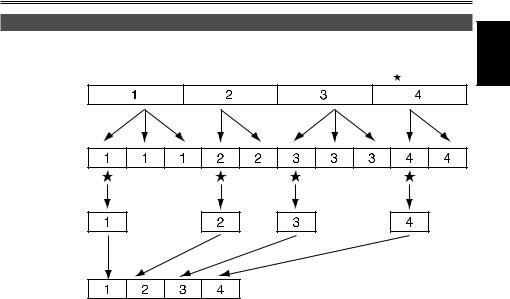
Variable frame rate (VFR)
This camera can perform low speed (undercrank) and high speed (overcrank) recording without the need for a frame rate converter (the camera must be set to 1080_24p or 1080_30p).
: Valid frames
Camera
24P
24PN
24P mode:
Shoots 24 frames a second in native mode. The images (shot at 24 frames a second) are recorded into 24 frames as the video signal.
•When VFR is set, the INTERVAL REC function, relay recording function, and PRE REC function are automatically set to OFF, and TCG is automatically set to REC RUN.
•The frame rate cannot be changed during recording.
•VFR shooting is only possible when shooting with REC FORMAT set to 1080_24p, 1080_30p or 1080_25p. VFR shooting does not work in the 720p mode.
The recording frame rate can be set to any one from the 20 frame rates given in the following table.
There is a slight a difference between the displayed recording frame rate and the actual recording frame rate. Please refer to the table below.
When SYSTEM FREQ is set to 59.94 Hz
Indicated |
|
|
|
|
|
|
|
|
|
|
|
|
|
|
|
|
|
|
|
|
recording |
60 |
54 |
48 |
44 |
40 |
36 |
34 |
32 |
30 |
28 |
27 |
26 |
25 |
24 |
22 |
21 |
20 |
18 |
15 |
12 |
frame rate |
|
|
|
|
|
|
|
|
|
|
|
|
|
|
|
|
|
|
|
|
Actual |
|
|
|
|
|
|
|
|
|
|
|
|
|
|
|
|
|
|
|
|
recording |
59.94 |
53.74 |
47.54 |
43.96 |
39.96 |
35.97 |
33.88 |
31.73 |
29.97 |
27.83 |
27.25 |
25.97 |
24.98 |
23.98 |
21.98 |
20.75 |
19.98 |
17.63 |
14.99 |
11.99 |
frame rate |
|
|
|
|
|
|
|
|
|
|
|
|
|
|
|
|
|
|
|
|
Shooting
When SYSTEM FREQ is set to 50 Hz
Indicated |
|
|
|
|
|
|
|
|
|
|
|
|
|
|
|
|
|
|
|
|
recording |
50 |
48 |
45 |
42 |
37 |
34 |
32 |
30 |
28 |
27 |
26 |
25 |
24 |
23 |
22 |
21 |
20 |
18 |
15 |
12 |
frame rate |
|
|
|
|
|
|
|
|
|
|
|
|
|
|
|
|
|
|
|
|
Actual |
|
|
|
|
|
|
|
|
|
|
|
|
|
|
|
|
|
|
|
|
recording |
50.00 |
48.08 |
45.45 |
41.67 |
36.76 |
34.09 |
31.82 |
30.00 |
27.78 |
26.79 |
26.04 |
25.00 |
24.00 |
23.08 |
22.06 |
20.83 |
20.00 |
17.86 |
15.00 |
12.50 |
frame rate |
|
|
|
|
|
|
|
|
|
|
|
|
|
|
|
|
|
|
|
|
7

Shooting techniques for different targets (continued)
Native recording
1 Select 1080/24P recording format from the REC FORMAT option (page 51) on the settings menu SCENE FILE screen.
2 From the OPERATION TYPE option (page
51) on the settings menu SCENE FILE screen, select FILM CAM, and set the FRAME RATE (page 51) to an arbitrary recording frame rate.
3 Press the START/STOP button
Start native recording in VFR mode.
•Although the audio is not recorded, the sound is output from the AUDIO OUT terminal, HDMI
terminal, and SDI OUT terminal during setup and during recording.
•During the VFR mode, the camera is set to manual focus mode.
Standard recording
1 Select 1080/30P recording format from the REC FORMAT option (page 51) on the settings menu SCENE FILE screen.
2 From the OPERATION TYPE option (page
51) on the settings menu SCENE FILE screen, select FILM CAM, and set the FRAME RATE (page 51) to an arbitrary recording frame rate.
3 Press the START/STOP button.
Start standard recording in VFR mode.
•Although the audio is not recorded, the sound is output from the AUDIO OUT terminal, HDMI terminal, and SDI OUT terminal during setup and during recording.
•During the VFR mode, the camera is set to manual focus mode.
•2:2 pull down recording will be applied for a recording frame rate of 30P.
8

Use of Variable Frame Rate (VFR)
Normal speed shooting for movie production
When producing videos for screening, a frame rate of 24fps as used in film projection is standard (x1). By using the settings below, playback with the same quality as the film projection is possible. Film like high quality video can be produced through 1080p progressive and CINELIKE Gamma.
Recording format |
Recording frame rate |
|
(REC FORMAT) |
(FRAME RATE) |
|
1080P/24P |
24 fps* |
|
(native recording) |
||
|
Normal speed shooting for commercial/drama production
When producing videos for display on television screen such as HDTV/SDTV broadcast, a frame rate of 30fps is standard (x1). By using the settings below, playback with the same quality as broadcast is possible. Commercials and music videos can be recorded at film-like high quality, and at a frame rate suitable for television broadcast.
Recording format |
Recording frame rate |
|
(REC FORMAT) |
(FRAME RATE) |
|
1080/30P |
30 fps* |
|
(2:2 Pull down) |
||
|
||
1080/25P |
25 fps* |
Undercrank shooting
This is a quick motion effect that can be applied to scenes showing the flow of clouds, people standing in the middle of crowds, and kung fu, etc. For example, a quick motion effect of x2 can be gained if the VFR recording frame rate is set to 12fps when recording with the 24P recording format that specifies the playback frame rate.
Recording format |
Recording frame rate |
(REC FORMAT) |
(FRAME RATE) |
1080/24P |
Less than 22fps* |
1080/30P |
Less than 28fps* |
1080/25P |
Less than 24fps* |
Overcrank shooting
This is a slow motion effect that can be applied to scenes such as car chases, action, climaxes, etc. For example, a slow motion effect of 1/2 can be gained if the VFR recording frame rate is set to 60fps when recording with the 30P recording format that specifies the playback frame rate. 1080P progressive movies produce smooth, high quality slow motion.
Recording format |
Recording frame rate |
(REC FORMAT) |
(FRAME RATE) |
1080/24P |
Less than 25fps* |
1080/30P |
Less than 32fps* |
1080/25P |
Less than 26fps* |
*The recording frame rate (FRAME RATE) can be set to one of 20 values. (page 14)
Shooting
9
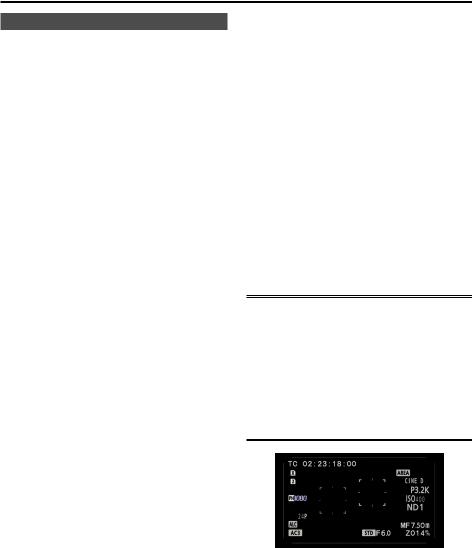
Shooting techniques for different targets (continued)
Shooting using the FUNCTION knob
The following types of recording can be carried out using the FUNCTION knob.
•Area auto focus function
Operates auto focus within an area frame selected using the FUNCTION knob.
•Area auto iris function
Automatically adjusts the iris value within an area frame selected using the FUNCTION knob. This function cannot be set when the FACE DETECT function has been set.
•Area luminance display
Displays an averaged luminance level within an area frame selected using the FUNCTION knob.
3 Press the FUNCTION knob again.
•The white frame turns yellow.
•When the frame is yellow, the FUNCTION knob function set via the MENU operates in the area inside the frame.
•Pressing the FUNCTION knob once more returns the yellow frame to the white frame.
•Switching AUTO/MANUAL for FOCUS/IRIS is normally carried out in the same way.
•The central luminance function does not operate when the area luminance display is operating.
•If the FUNCTION knob is held down for more than 2 seconds, the frame disappears and the area function is switched off.
1
2
Select the function from the FUNCTION KNOB option (page 53) on the settings menu SW MODE screen.
FOCUS: |
Area focus function and area focus |
|
bar function (during MENU setting) |
IRIS: |
Area iris function and area iris meter |
|
function (during MENU setting) |
YGET: |
Area luminance display |
FOCUS/IRIS:
Simultaneous operation of the area focus function and area iris function, simultaneous operation of the area focus bar function/area iris meter function (during MENU setting)
FOCUS/YGET:
Simultaneous operation of area focus function and area luminance display, simultaneous operation of area focus bar function (during MENU setting)
Press the FUNCTION knob.
•A white frame is displayed.
•There is no change in the operation of the camera other than the display of the frame.
4 Move the FUNCTION knob up and down, and right and left.
•The white frame changes position. Move the frame to the area you wish to select.
•The area function does not operate during face detection.
•The area function exits when the power switch is set to OFF or when the camera is switched to playback mode.
•Auto focus and auto iris may not be available depending on lens used.
•The area luminance, FOCUS BAR, and IRIS METER functions are available regardless of the lens used.
10
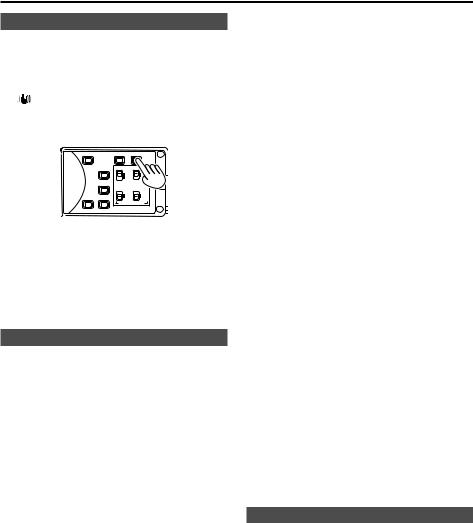
Optical Image Stabilizer
Use the Optical Image Stabilizer (OIS) to reduce the effects of camera shake when shooting by hand.
OIS button to turn the function on and appears on the viewfinder and the LCD
monitor when this function is on. Turn the function off when using a tripod for more natural images.
BARS |
ZEBRA |
OIS |
EVF DTL |
CH1 SEL |
CH2 |
|
INT(L) |
|
|
INPUT1 |
|
|
INPUT2 |
|
WFM |
AUDIO |
|
|
INPUT1 |
|
|
ON |
ON |
COUNTER-RESET/TC SET |
OFF |
OFF |
|
MIC POWER +48V |
|
•For lenses that have an OIS.. button, only the lens button is active and the button on the camera is deactivated. Also, some lenses do not have an OIS function.
•This function will not be as effective when the
vibration is severe or when tracking a moving
subject. FOCUS POWER
Adding effects to images
Press the USER button you have allocated to the BLACKFADE or WHITEFADE feature to add fading effects to your images. The button’s function is forcibly canceled during playback or REC CHECK and also when thumbnails are displayed.
BLACKFADE:
Press the button to fade out to black. Audio also fades out. Fade-in starts after fade-out, when the button is released.
WHITEFADE:
Press the button to fade out to white. Audio also fades out. Fade-in starts after fade-out, when the button is released.
Using the USER buttons |
|
|
|
Shooting |
|||
You can allocate one of thirteen features to each of |
|||
|
|||
the three USER buttons. |
|
||
Use these buttons to change shooting settings |
|
||
quickly or add effects to the images you are |
|
||
|
|||
shooting. |
|
||
The following features are allocated to the buttons |
|
||
at the time of shipping. |
|
||
USER1: FA |
|
||
USER2: ATW LOCK |
|
||
USER3: REC CHECK |
|
||
For details, see the setup menus, SW MODE |
|
||
screen, USER1 SW to USER3 SW. (Page 55) |
|
||
If you press a USER button to which one of the |
|
||
functions has been assigned, and then turn OFF |
|
||
the power or change the mode during operation of |
|
||
the USER button function, the effect added to the |
|
||
image will not be retained. |
|
||
|
|
|
|
Backlight compensation |
|
||
Press the USER button you have allocated to the |
|
||
BACKLIGHT feature when shooting subjects lit |
|
||
from the back. |
|
||
BACK appears on the screen. |
|
||
Backlight compensation adjusts the iris so the |
|
||
subject doesn’t come out dark. |
|
||
Press the same USER button to turn the feature |
|
||
off. (In the manual iris mode, the iris status is |
|
||
retained at the corresponding point even when |
|
||
backlight compensation is canceled.) |
|
||
•The backlight compensation function does not operate with lenses in which AUTO IRIS is not functioning.
Color bars
Press the BARS button in the CAM mode to output a color bar screen to a television or monitor so you can adjust them. Press the button again to turn the feature off.
•While the color bar is displayed, a test tone of
1 kHz will be output from the headphone terminal or the AUDIO OUT terminal. There will be no speaker output.
•The color bar can be recorded by pressing the START/STOP button.
•The color bar display is canceled when the power is turned off.
11

Shooting techniques for different targets (continued)
Wave form monitor function
An image wave form can be displayed on the LCD monitor by pressing the WFM button while in CAM mode.
Press the button again to return to the normal display.
•Switching the wave form display, vector display, and wave/vector display is possible from the WFM item (page 55) in the SW MODE screen of the settings menu.
•Wave forms will not be displayed in the viewfinder.
•Wave forms cannot be recorded.
•While wave forms are displayed, use the viewfinder as well because a part of the recording screen and screen display will be hidden by wave forms.
Adjusting the volume
AUDIO MON/ADV
FOCUS |
FUNCTION |
USER 1 |
DISP/ |
POWER.. |
|
MODECHK |
MODE |
||||
IRIS GAIN |
WHITEBAL |
USER 2 |
|
AUDIOLEVEL |
|
If you are monitoring the sound through headphones while shooting, you can adjust the volume with the AUDIO MON/ADV buttons.
•To adjust the recording level. (Page 18)
•Volume adjustments will be memorized if the power is turned off by moving the POWER switch to the OFF position.
12

Shot mark function
The marks attached to the thumbnails of clips are called shot marks. On the thumbnail screen monitor you can select only those clips with a shot mark and display them or play them back. During recording, when you press the USER button to which the SHOT MARK function has been allocated, MARK ON appears in the LCD monitor or the viewfinder, and a shot mark is set for the thumbnail of the clip being recorded. If you press the button again, the shot mark is released. You can also set or release the shot marks by performing the thumbnail operations for clips. (Page 31)
However, note that you cannot set or release shot marks during playback.
•INVALID appears when you cannot set or release shot marks.
LAST CLIP function
The most recently recorded clip can be deleted at the touch of a button by allocating the LAST CLIP function to any of the USER 1 - 3 buttons.
Press the USER button allocated for the LAST CLIP function to display YES/NO on the screen. Select YES to delete the most recently recorded clip.
•Select NO not to delete the clip.
•If the camera has been switched to PB mode or the recording format has been changed since recording was completed, clips cannot be deleted even if the button is pressed. Clips also cannot be deleted if the power has been switched off and back on again.
•Clips cannot be deleted even if the button is pressed if the memory card has been removed and reinserted since recording was completed.
Shooting
Index recording
This function allows you to add an index at a certain point of a clip during the recording or playback.
Press the USER button allocated to the INDEX function during recording to record an index signal at this point of the clip. (Pages 11, 55)
Indexes may also be added during playback, and it is also possible to select only clips with indexes for display or playback. (Pages 34, 35)
•Up to 100 indexes can be recorded for one clip.
•When the number of indexes exceeds 100, INVALID is displayed, and no further indexes can be added even when the steps for adding indexes are taken.
•When repeatedly adding indexes, leave a gap of at least one second between adding one index and the next. If indexes are added with a gap of less than one second between them, only the first operation will be valid.
CAPTURE function
If the CAPTURE feature is assigned to any of the USER 1 – 3 buttons, still images can be shot.
•The number of recorded pixels and quality of the still images cannot be changed.
•This function does not operate when a movie is being recorded, or when the PRE REC mode is in use.
•The SD memory card used for recording is the same as that used for video recording.
13
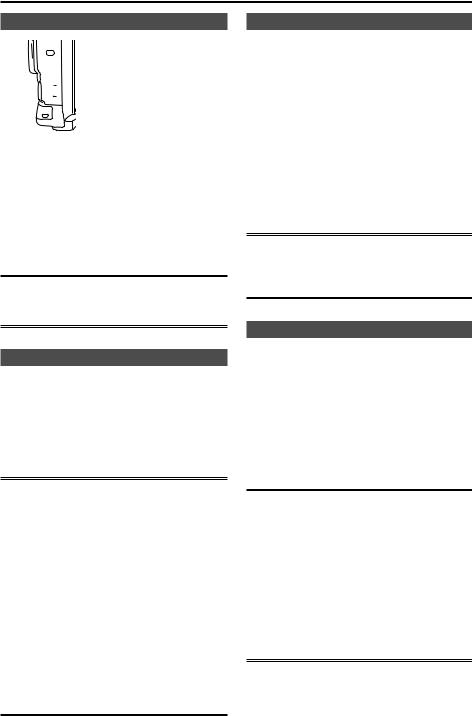
Adjusting the shutter speed
Using the SHUTR/F.RATE dial
 DIAL SELECT button
DIAL SELECT button
 SHUTR/F.RATE dial
SHUTR/F.RATE dial
Press the DIAL SELECT button.
•The role of the SHUTR/F.RATE dial changes in the following order.
SHUTTER → SYNCRO SCAN → FRAME RATE → DIAL LOCK → SHUTTER →
•SYNCRO SCAN can be selected when the SHUTTER is set to SYNCRO SCAN. FRAME RATE can be selected in the FILM CAM mode when the REC FORMAT is 1080/24P, 30P, and 25P.
To prevent incorrect operation, it is recommended that you selecting DIAL LOCK using the DIAL SELECT button after setting.
Setting the SHUTTER
1 Select the SHUTTER function with the DIAL SELECT button.
2 Press the SHUTR/F.RATE dial.
•The shutter will turn ON/OFF.
•The shutter speed is changed in the order shown on the following page by turning the SHUTR/F.RATE dial when the shutter is ON.
•Remember that the faster the shutter speed, the lower the sensitivity.
•Focusing on the subject would take longer if the shutter speed is reduced. It is therefore recommended that the unit be secured to a tripod, etc. during shooting.
•Under the lighting of electric discharge tubes such as fluorescent lamps, horizontal bands may appear on the screen. Adjusting the shutter speed may improve this condition.
•A subject that quickly crosses the camera may appear distorted when shot. This is caused due to the signal reading system of the imaging element (MOS sensor), and is not a defect.
•At slow shutter speeds (1/2 to 1/15), white, red, green, or blue dots may appear on the screen. However, this is not a defect.
Setting the SYNCRO SCAN
1 Select SYNCRO SCAN from the SHUTTER settings.
2 Select the SYNCRO SCAN function with the DIAL SELECT button.
3 Turn the SHUTR/F.RATE dial.
•The SYNCRO SCAN shutter speed can be set.
•The speed of change increases when turning the SHUTR/F.RATE while holding it down.
•SYNCRO SCAN can also be set from the SYNCRO SCAN item in the SCENE FILE screen of MENU settings.
Setting format differs depending on the MENUSCENE FILE-OPERATION TYPE.
FILM CAM: angle display (180.0d etc.) VIDEO CAM: speed display (1/48.0 etc.)
FRAME RATE setting
1 Select the FRAME RATE function with the DIAL SELECT button.
2 Press the SHUTR/F.RATE dial.
The camera is in VFR mode.
•The FRAME RATE can be set by turning the SHUTR/F.RATE dial.
•FRAME RATE can also be set from the FRAME RATE item in the SCENE FILE screen of MENU settings.
•Before using the FRAME_RATE function, it is necessary for the MENU-SCENE FILEOPERATION TYPE to be set to FILM CAM, and the MENU-SCENE FILE-REC FORMAT to be set to PH1080/24P or PH1080/30P (or PH1080/25P).
•The FRAME RATE function cannot be set when SDI 24PsF is set to ON in the AV IN/ OUT SETUP screen of MENU settings.
•When the FRAME RATE function is set to ON, the camera is automatically set to manual focus.
14
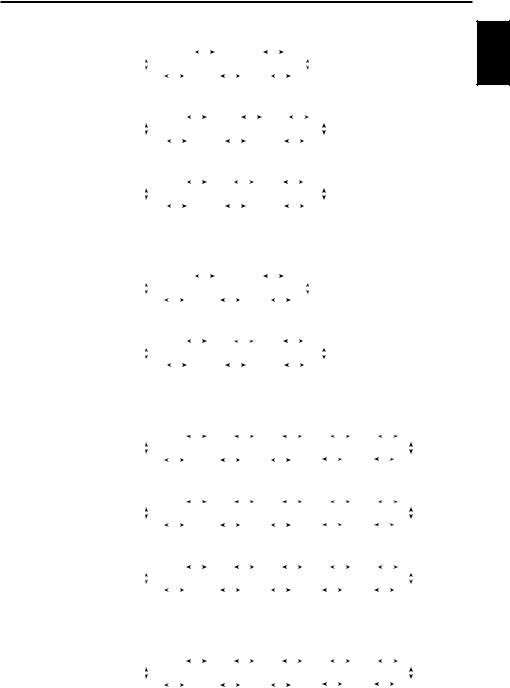
When SYSTEM FREQ = 59.94Hz /OPERATION TYPE = FILM CAM
1080/60i, 720/60P |
|
|
|
|
|
|
|
|
|
|
|
|
|
|
|
|
|
|
|
|
|
|
|
|
|
|
|
|
|
|
|
|
|
|
|
|
|
|
|
|
|
|
|
|
|
|
|
|
|
|
|
|
|
|
|
|
|
Normal (OFF) 1/60 |
SYNCRO SCAN |
|
|
|
|
|
|
|
|
|
1/100 |
|
|
|
|
|
|
|
|
|
|
|
1/120 |
|
|
|
|
|
|
|
|
|
|
|
|
|
|||||||||||||||||||||
|
|
|
|
|
|
|
|
|
|
|
|
|
|
|
|
|
|
|
|
|
|
|
|
|
|
|
|
|
|
|
|
|
|
||||||||||||||||||||||||
|
|
|
|
|
|
|
|
|
|
|
|
|
|
|
|
|
|
|
|
|
|
|
|
|
|
|
|
|
|
|
|
|
|
|
|
|
|
|
|
|
|
|
|
|
|
|
|
|
|
|
|
|
|
|
|
||
|
|
|
|
|
|
|
|
|
|
|
|
|
|
|
|
|
|
|
|
|
|
|
|
|
|
|
|
|
|
|
|
|
|
|
|
|
|
|
|
|
|
|
|
|
|
|
|
|
|
|
|
|
|
|
|
||
|
1/2000 |
|
|
|
|
1/1000 |
|
|
|
|
1/500 |
|
|
|
|
|
|
1/250 |
|
|
|
|
|
|
|
|
|
|
|
|
|
||||||||||||||||||||||||||
|
|
|
|
|
|
|
|
|
|
|
|
|
|
|
|
|
|
|
|
|
|
|
|||||||||||||||||||||||||||||||||||
|
|
|
|
|
|
|
|
|
|
|
|
|
|
|
|
|
|
|
|
|
|
|
|
|
|
|
|
|
|
|
|
|
|
|
|
|
|
|
|
|
|
|
|
|
|
|
|
|
|
|
|
|
|
|
|
|
|
1080/30P, 720/30P |
|
|
|
|
|
|
|
|
|
|
|
|
|
|
|
|
|
|
|
|
|
|
|
|
|
|
|
|
|
|
|
|
|
|
|
|
|
|
|
|
|
|
|
|
|
|
|
|
|
|
|
|
|
|
|
|
|
Normal (OFF) 1/50 |
SYNCRO SCAN |
|
|
|
|
|
|
|
1/30 |
|
|
|
|
|
|
|
|
|
1/60 |
|
|
|
|
|
|
|
1/120 |
|
|
|
|
|
|
|
|
|
|
|
|||||||||||||||||||
|
|
|
|
|
|
|
|
|
|
|
|
|
|
|
|
|
|
|
|
|
|
|
|
|
|
|
|
|
|
|
|
||||||||||||||||||||||||||
|
|
|
|
|
|
|
|
|
|
|
|
|
|
|
|
|
|
|
|
|
|
|
|
|
|
|
|
|
|
|
|
|
|
|
|
|
|
|
|
|
|
|
|
|
|
|
|
|
|
|
|
|
|||||
|
|
|
|
|
|
|
|
|
|
|
|
|
|
|
|
|
|
|
|
|
|
|
|
|
|
|
|
|
|
|
|
|
|
|
|
|
|
|
|
|
|
|
|
|
|
|
|
|
|
|
|
|
|||||
|
1/2000 |
|
|
|
|
1/1000 |
|
|
|
|
|
|
|
1/500 |
|
|
|
|
|
|
|
|
1/250 |
|
|
|
|
|
|
|
|
|
|
|
|||||||||||||||||||||||
|
|
|
|
|
|
|
|
|
|
|
|
|
|
|
|
|
|
|
|
|
|
|
|
|
|
|
|
|
|||||||||||||||||||||||||||||
|
|
|
|
|
|
|
|
|
|
|
|
|
|
|
|
|
|
|
|
|
|
|
|
|
|
|
|
|
|
|
|
|
|
|
|
|
|
|
|
|
|
|
|
|
|
|
|
|
|
|
|
|
|
|
|
|
|
1080/24P, 720/24P |
|
|
|
|
|
|
|
|
|
|
|
|
|
|
|
|
|
|
|
|
|
|
|
|
|
|
|
|
|
|
|
|
|
|
|
|
|
|
|
|
|
|
|
|
|
|
|
|
|
|
|
|
|
|
|
|
|
Normal (OFF) 1/50 |
SYNCRO SCAN |
|
|
|
|
|
|
|
|
1/24 |
|
|
|
|
|
|
|
1/60 |
|
|
|
|
|
|
|
1/120 |
|
|
|
|
|
|
|
|
|
|
|
||||||||||||||||||||
|
|
|
|
|
|
|
|
|
|
|
|
|
|
|
|
|
|
|
|
|
|
|
|
|
|
|
|
|
|
|
|
||||||||||||||||||||||||||
|
|
|
|
|
|
|
|
|
|
|
|
|
|
|
|
|
|
|
|
|
|
|
|
|
|
|
|
|
|
|
|
|
|
|
|
|
|
|
|
|
|
|
|
|
|||||||||||||
|
|
|
|
|
|
|
|
|
|
|
|
|
|
|
|
|
|
|
|
|
|
|
|
|
|
|
|
|
|
|
|
|
|
|
|
|
|
|
|
|
|
|
|
|
|||||||||||||
|
1/2000 |
|
|
|
|
1/1000 |
|
|
|
|
|
|
|
1/500 |
|
|
|
|
|
|
|
1/250 |
|
|
|
|
|
|
|
|
|
|
|
||||||||||||||||||||||||
|
|
|
|
|
|
|
|
|
|
|
|
|
|
|
|
|
|
|
|
|
|
|
|
|
|
|
|
||||||||||||||||||||||||||||||
|
|
|
|
|
|
|
|
|
|
|
|
|
|
|
|
|
|
|
|
|
|
|
|
|
|
|
|
|
|
|
|
|
|
|
|
|
|
|
|
|
|
|
|
|
|
|
|
|
|
|
|
|
|
|
|
||
SYSTEM FREQ = 50Hz /OPERATION TYPE = FILM CAM |
|
|
|
|
|
|
|
|
|
|
|
|
|
|
|
|
|
|
|
|
|||||||||||||||||||||||||||||||||||||
1080/50i, 720/50P |
|
|
|
|
|
|
|
|
|
|
|
|
|
|
|
|
|
|
|
|
|
|
|
|
|
|
|
|
|
|
|
|
|
|
|
|
|
|
|
|
|
|
|
|
|
|
|
|
|
|
|
|
|
|
|
|
|
Normal (OFF) 1/50 |
SYNCRO SCAN |
|
|
|
|
|
|
|
|
|
1/60 |
|
|
|
|
|
|
|
|
|
|
|
1/120 |
|
|
|
|
|
|
|
|
|
|
|
|
|
|||||||||||||||||||||
|
|
|
|
|
|
|
|
|
|
|
|
|
|
|
|
|
|
|
|
|
|
|
|
|
|
|
|
|
|
|
|||||||||||||||||||||||||||
|
|
|
|
|
|
|
|
|
|
|
|
|
|
|
|
|
|
|
|
|
|
|
|
|
|
|
|
|
|
|
|
|
|
|
|
|
|
|
|
|
|
|
|
||||||||||||||
|
|
|
|
|
|
|
|
|
|
|
|
|
|
|
|
|
|
|
|
|
|
|
|
|
|
|
|
|
|
|
|
|
|
|
|
|
|
|
|
|
|
|
|
|
|||||||||||||
|
1/2000 |
|
|
|
|
1/1000 |
|
|
|
|
1/500 |
|
|
|
|
|
|
1/250 |
|
|
|
|
|
|
|
|
|
|
|
|
|
||||||||||||||||||||||||||
|
|
|
|
|
|
|
|
|
|
|
|
|
|
|
|
|
|
|
|
|
|
|
|
|
|||||||||||||||||||||||||||||||||
|
|
|
|
|
|
|
|
|
|
|
|
|
|
|
|
|
|
|
|
|
|
|
|
|
|
|
|
|
|
|
|
|
|
|
|
|
|
|
|
|
|
|
|
|
|
|
|
|
|
|
|
|
|
|
|
|
|
1080/25P, 720/25P |
|
|
|
|
|
|
|
|
|
|
|
|
|
|
|
|
|
|
|
|
|
|
|
|
|
|
|
|
|
|
|
|
|
|
|
|
|
|
|
|
|
|
|
|
|
|
|
|
|
|
|
|
|
|
|
|
|
Normal (OFF) 1/50 |
SYNCRO SCAN |
|
|
|
|
|
|
|
|
1/25 |
|
|
|
|
|
|
|
1/60 |
|
|
|
|
|
|
|
1/120 |
|
|
|
|
|
|
|
|
|
|
|
||||||||||||||||||||
|
|
|
|
|
|
|
|
|
|
|
|
|
|
|
|
|
|
|
|
|
|
|
|
|
|
|
|
|
|
|
|
||||||||||||||||||||||||||
|
|
|
|
|
|
|
|
|
|
|
|
|
|
|
|
|
|
|
|
|
|
|
|
|
|
|
|
|
|
|
|
|
|
|
|
|
|
|
|
|
|
||||||||||||||||
|
|
|
|
|
|
|
|
|
|
|
|
|
|
|
|
|
|
|
|
|
|
|
|
|
|
|
|
|
|
|
|
|
|
|
|
|
|
|
|
|
|
||||||||||||||||
|
1/2000 |
|
|
|
|
1/1000 |
|
|
|
|
|
|
|
1/500 |
|
|
|
|
|
|
1/250 |
|
|
|
|
|
|
|
|
|
|
|
|||||||||||||||||||||||||
|
|
|
|
|
|
|
|
|
|
|
|
|
|
|
|
|
|
|
|
|
|
|
|
|
|
|
|||||||||||||||||||||||||||||||
|
|
|
|
|
|
|
|
|
|
|
|
|
|
|
|
|
|
|
|
|
|
|
|
|
|
|
|
|
|
|
|
|
|
|
|
|
|
|
|
|
|||||||||||||||||
SYSTEM FREQ = 59.94Hz /OPERATION TYPE = VIDEO CAM |
|
|
|
|
|
|
|
|
|
|
|
|
|
|
|
|
|
|
|
|
|||||||||||||||||||||||||||||||||||||
1080/60i, 720/60P |
|
|
|
|
|
|
|
|
|
|
|
|
|
|
|
|
|
|
|
|
|
|
|
|
|
|
|
|
|
|
|
|
|
|
|
|
|
|
|
|
|
|
|
|
|
|
|
|
|
|
|
|
|
|
|
|
|
Normal (OFF) 1/60 |
SYNCRO SCAN |
|
|
|
|
|
1/2 |
|
|
|
|
|
|
|
|
1/4 |
|
|
|
|
|
|
1/8 |
|
|
|
|
1/15 |
|
|
|
|
|
1/30 |
|||||||||||||||||||||||
|
|
|
|
|
|
|
|
|
|
|
|
|
|
|
|
|
|
|
|
|
|
||||||||||||||||||||||||||||||||||||
|
|
|
|
|
|
|
|
|
|
|
|
|
|
|
|
|
|
|
|
|
|
|
|
|
|
|
|
|
|
|
|
|
|
|
|
|
|
|
|
|
|||||||||||||||||
|
|
|
|
|
|
|
|
|
|
|
|
|
|
|
|
|
|
|
|
|
|
|
|
|
|
|
|
|
|
|
|
|
|
|
|
|
|
|
|
|
|
|
|||||||||||||||
|
1/2000 |
|
|
|
|
1/1000 |
|
|
|
|
1/500 |
|
|
|
|
|
|
1/250 |
|
|
1/120 |
|
|
|
1/100 |
||||||||||||||||||||||||||||||||
|
|
|
|
|
|
|
|
|
|
|
|
|
|
|
|
|
|
|
|
||||||||||||||||||||||||||||||||||||||
|
|
|
|
|
|
|
|
|
|
|
|
|
|
|
|
|
|
|
|
|
|
|
|
|
|
|
|
|
|
|
|
|
|
|
|
|
|
|
|
|
|
|
|
|
|
|
|
|
|
|
|
|
|
|
|
|
|
1080/30P, 720/30P |
|
|
|
|
|
|
|
|
|
|
|
|
|
|
|
|
|
|
|
|
|
|
|
|
|
|
|
|
|
|
|
|
|
|
|
|
|
|
|
|
|
|
|
|
|
|
|
|
|
|
|
|
|
|
|
|
|
Normal (OFF) 1/50 |
SYNCRO SCAN |
|
|
|
|
|
|
1/2 |
|
|
|
|
|
|
|
|
|
1/4 |
|
|
|
|
|
|
1/8 |
|
|
|
|
|
1/15 |
|
|
|
|
|
1/30 |
||||||||||||||||||||
|
|
|
|
|
|
|
|
|
|
|
|
|
|
|
|
|
|||||||||||||||||||||||||||||||||||||||||
|
|
|
|
|
|
|
|
|
|
|
|
|
|
|
|
|
|
|
|
|
|
|
|
|
|
|
|
|
|
|
|||||||||||||||||||||||||||
|
|
|
|
|
|
|
|
|
|
|
|
|
|
|
|
|
|
|
|
|
|
|
|
|
|
|
|
|
|
|
|
|
|||||||||||||||||||||||||
|
1/2000 |
|
|
|
|
1/1000 |
|
|
|
|
1/500 |
|
|
|
|
|
|
1/250 |
|
|
|
1/120 |
|
|
1/60 |
||||||||||||||||||||||||||||||||
|
|
|
|
|
|
|
|
|
|
|
|
|
|
|
|
|
|
|
|||||||||||||||||||||||||||||||||||||||
|
|
|
|
|
|
|
|
|
|
|
|
|
|
|
|
|
|
|
|
|
|
|
|
|
|
|
|
|
|
|
|
|
|
|
|
|
|
|
|
|
|
|
|
|
|
|
|
|
|
|
|
|
|
|
|
|
|
1080/24P, 720/24P |
|
|
|
|
|
|
|
|
|
|
|
|
|
|
|
|
|
|
|
|
|
|
|
|
|
|
|
|
|
|
|
|
|
|
|
|
|
|
|
|
|
|
|
|
|
|
|
|
|
|
|
|
|
|
|
|
|
Normal (OFF) 1/50 |
SYNCRO SCAN |
|
|
|
|
|
|
1/2 |
|
|
|
|
|
|
|
|
|
1/3 |
|
|
|
|
|
|
1/6 |
|
|
|
|
|
1/12 |
|
|
|
|
|
1/24 |
||||||||||||||||||||
|
|
|
|
|
|
|
|
|
|
|
|
|
|
|
|
|
|||||||||||||||||||||||||||||||||||||||||
|
|
|
|
|
|
|
|
|
|
|
|
|
|
|
|
|
|
|
|
|
|
|
|||||||||||||||||||||||||||||||||||
|
|
|
|
|
|
|
|
|
|
|
|
|
|
|
|
|
|
|
|
|
|
|
|
|
|||||||||||||||||||||||||||||||||
|
1/2000 |
|
|
|
|
1/1000 |
|
|
|
|
1/500 |
|
|
|
|
|
|
1/250 |
|
|
|
1/120 |
|
|
1/60 |
||||||||||||||||||||||||||||||||
|
|
|
|
|
|
|
|
|
|
|
|
|
|
|
|
|
|
|
|||||||||||||||||||||||||||||||||||||||
|
|
|
|
|
|
|
|
|
|
|
|
|
|
|
|
|
|
|
|
|
|
|
|
|
|
|
|
|
|
|
|
|
|
|
|
|
|
|
|||||||||||||||||||
SYSTEM FREQ = 50Hz /OPERATION TYPE = VIDEO CAM |
|
|
|
|
|
|
|
|
|
|
|
|
|
|
|
|
|
|
|
|
|||||||||||||||||||||||||||||||||||||
1080/50i, 1080/25P, 720/50P, 720/25P |
|
|
|
|
|
|
|
|
|
|
|
|
|
|
|
|
|
|
|
|
|
|
|
|
|
|
|
|
|
|
|
|
|
|
|
|
|
|
|
|
|
|
|
|
|
|
|
|
|
|
|||||||
Normal (OFF) 1/50 |
SYNCRO SCAN |
|
|
|
|
|
|
1/2 |
|
|
|
|
|
|
|
|
|
1/3 |
|
|
|
|
|
|
1/6 |
|
|
|
|
|
1/12 |
|
|
|
|
|
1/25 |
||||||||||||||||||||
|
|
|
|
|
|
|
|
|
|
|
|
|
|
|
|
|
|||||||||||||||||||||||||||||||||||||||||
|
|
|
|
|
|
|
|
|
|
|
|
|
|
|
|
|
|
|
|
|
|
|
|||||||||||||||||||||||||||||||||||
|
|
|
|
|
|
|
|
|
|
|
|
|
|
|
|
|
|
|
|
|
|
|
|
|
|||||||||||||||||||||||||||||||||
|
1/2000 |
|
|
|
|
1/1000 |
|
|
|
|
1/500 |
|
|
|
|
|
|
1/250 |
|
|
|
1/120 |
|
|
1/60 |
||||||||||||||||||||||||||||||||
|
|
|
|
|
|
|
|
|
|
|
|
|
|
|
|
|
|
|
|||||||||||||||||||||||||||||||||||||||
|
|
|
|
|
|
|
|
|
|
|
|
|
|
|
|
|
|
|
|
|
|
|
|
|
|
|
|
|
|
|
|
|
|
|
|
|
|
|
|
|
|
|
|
|
|
|
|
|
|
|
|
|
|
|
|
|
|
Shooting
15
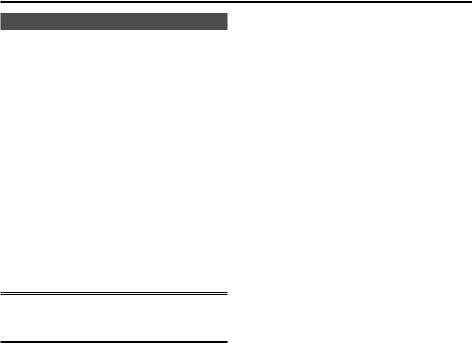
Adjusting the shutter speed (continued)
Synchro scan
The syncro scan shutter speed used when shooting screens such as a TV screen or computer monitor is set using the SHUTR/F RATE dial (page 14) or the SYNCRO SCAN option on the settings menu SCENE FILE screen. (page 51)
•Adjust the shutter speed to match the frequency of the television or computer monitor to minimize the horizontal noise that appears when shooting such subjects.
•By switching to progressive mode you can also shoot PAL system television screens.
•If the set value of the SYNCRO SCAN item of settings menu is displayed in gray, it cannot be used with the current recording format. This function will only operate for preset values for each recording format, as listed below.
60i/60P mode: |
1/60 |
30P mode: |
1/30 |
You can change the progressive mode in the setup menu with REC FORMAT in the SCENE FILE screen. (Page 51)
16
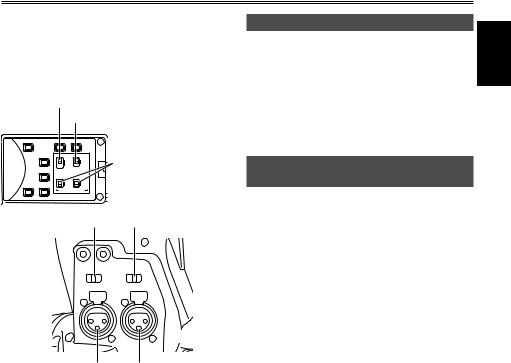
Switching Audio Input
During shooting, you can record up to two channels of sound. You can also switch the input sound to be recorded on each of the channels to the built-in microphones, external microphones or audio equipment connected to camera.
CH1 SELECT switch
CH2 SELECT switch
BARS |
ZEBRA |
OIS |
|
EVF DTL |
CH1 SEL CH2 SEL |
|
|
|
INT(L) |
INPUT1 |
INPUT 1/2 |
|
INPUT2 |
INPUT2 |
|
|
INPUT1 |
(MIC POWER +48V) |
|
WFM |
INPUT1 INPUT2 |
||
AUDIO |
switches |
||
|
MIC POWER +48V |
||
|
ON |
ON |
|
COUNTER-RESET/TC SET |
OFF |
OFF |
|
INPUT 1 switch |
INPUT 2 switch |
||
INPUT 1 terminal |
INPUT 2 terminal |
Using the built-in microphone
1 Switch the CH1 SELECT switch to INT (L).
•Audio from the built-in microphone Lch is recorded to audio channel 1.
2 Switch the CH2 SELECT switch to INT (R).
•Audio from the built-in microphone Rch is recorded to audio channel 2.
Using an external microphone and audio equipment
1 Connect an external microphone or audio equipment to the INPUT 1/2 (XLR 3-pin) terminals. (Page 41)
2 Use the INPUT 1/2 switches to switch the audio input.
LINE: (audio equipment is connected)
Input level is 0 dBu.
MIC: (an external microphone is connected)
Input level is -50 dBu.
You can change the input level to -60 dBu in the setup menus, RECORDING SETUP
screen MIC GAIN1 and MIC GAIN2. (Page 56) Be aware that sensitivity will be higher if
you choose -60 dBu so you will record more noise.
3 When using the phantom microphone (which requires + 48V power supply), set the INPUT 1/2 (MIC POWER +48V) switches to ON.
ON: (When using the phantom microphone)
+48V power supply to INPUT 1/2 terminals.
OFF: (When a phantom microphone is not connected)
No power supply for INPUT 1/2 terminals.
•The battery will discharge faster if you use a phantom microphone.
•Set to OFF if you connect equipment not compatible with +48V. You can damage such equipment if you leave the setting at ON.
•When using the AG-MC200G (optional), set the MIC GAIN item to -50 dBu.
Shooting
17
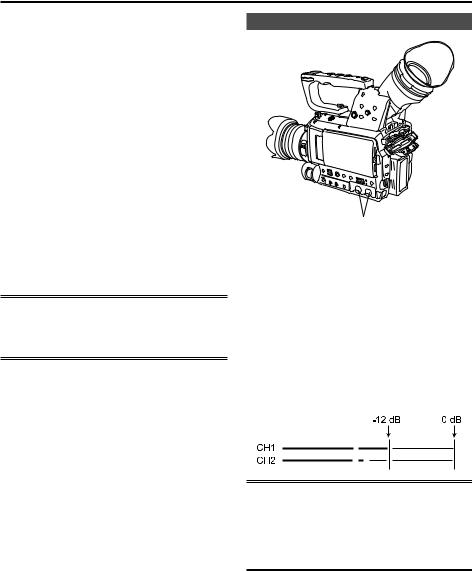
Switching Audio Input (continued)
4 Use the CH1 SELECT switch to select the input signal to be recorded to audio channel 1. INT (L):
Audio from the built-in microphone Lch is recorded to audio channel 1.
INPUT 1:
Audio from a device connected to INPUT 1 terminal is recorded to channel 1.
INPUT 2:
Audio from a device connected to INPUT 2 terminal is recorded to channel 1.
5 Use the CH2 SELECT switch to select the input signal to be recorded to audio channel 2. INT (R):
Audio from the built-in microphone Rch is recorded to audio channel 2.
INPUT 2:
Audio from a device connected to INPUT 2 terminal is recorded to channel 2.
•When inputting the microphone signal to channels 1 and 2, connect the microphone to INPUT 2 and switch both CH1 SELECT and CH2 SELECT to INPUT 2.
Adjusting the recording level
AUDIO control knobs
Use the AUDIO control knobs to adjust the recording level of the built-in microphone or of audio signals input through the INPUT 1/2 (XLR 3-pin) terminals.
To adjust the volume of the sound for monitoring. (Page 12)
To adjust the recording level of the audio signals, turn the AUDIO control knobs while referring to the audio level meter at the bottom left of the viewfinder and LCD monitor, regardless of the MIC ALC option setting (Page 56) on the RECORDING SETUP screen of the setting menu.
•Check the recording volume level prior to shooting.
•The recording level of this camera is set approximately 8 dB higher than Panasonic broadcasting camera recorders (AJ series products).
18
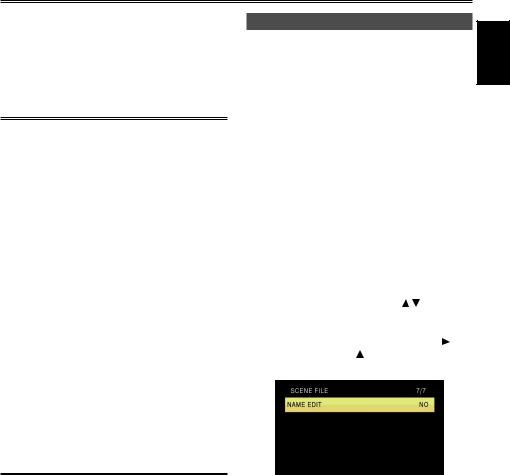
Using scene files
The settings according to the variety of shooting circumstances are stored SCENE FILE MENU. They are selected via the SCENE SELECT on the settings menu SCENE FILE screen.
When the camera-recorder is shipped from the factory, the following files are stored.
F1:
File suitable for normal shooting.
F2: FLUO.
File suitable for shooting under fluorescent lights, ie. indoors.
F3: SPARK
File suitable for shooting with fuller variations of resolution, coloring and contrast.
F4: B-STR
File for broadening the contrast of dark parts, such as when shooting sunsets.
F5: CINE V
File suitable for shooting movie-like scenes where the contrast is to be emphasized. (The recording format remains unchanged even when the scene file is changed. It must be set using the REC FORMAT item on the SCENE FILE screen. (Page 51))
F6: CINE D
File suitable for shooting movie-like scenes where the dynamic range is to be
emphasized. (The recording format remains unchanged even when the scene file is changed. It must be set using the REC FORMAT item on the SCENE FILE screen. (Page 51))
Changing scene file settings
The setting value of the scene file can be changed. Also you can save the changed scene file to each position of the SCENE FILE dial.
Example: Change the name of the scene file.
1 Set the POWER switch to ON.
2 Select the scene file to be changed in the SCENE FILE MENU.
3 In the setup menus, select the SCENE FILE screen.
•For menu operation (Page 44 of Vol.1)
•Operations may also be performed using buttons on the remote control that correspond to those on the camera. For
details, see “Description of parts (Remote control) ”. (Page 23 of Vol.1)
4 Tilt the Operation lever in the |
directions |
and select the NAME EDIT item. |
|
5 Push the Operation lever (or tilt in the direction), tilt in the direction to select YES, and push the Operation lever again.
Shooting
19

Using scene files (continued)
6 Set a 6-character filename with the Operation lever when the following screen is displayed.
Set the same as user information. (Page 27)
•Characters that can be set
Space, A to Z, 0 to 9, : ; < = > ? @ [  ] ^_-./ If the RESET/TC SET button is pressed when the filename has been set, the characters are cleared.
] ^_-./ If the RESET/TC SET button is pressed when the filename has been set, the characters are cleared.
7 After you finish setting the filename, push the Operation lever.
8 Select YES on the confirmation screen.
•Selecting YES will close the NAME EDIT screen and confirm all changes.
•Once confirmed, all changed names and values will be saved even if the power is switched off or the scene dial is moved.
20
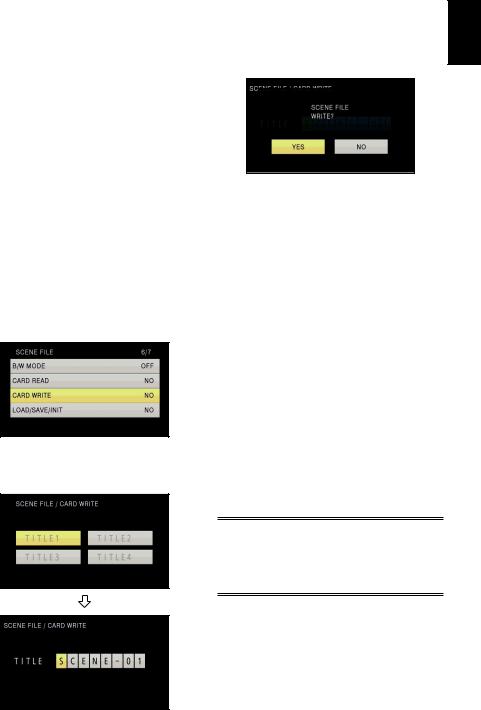
Saving scene files and other settings on SD Memory Cards
You can save up to four scene file settings or other settings as files on an SD Memory Card, and you can also load them from the card.
•In the case of the scene files, the current settings are automatically saved in the unit, and the saved data is written on an SD Memory Card. When data has been read from an SD Memory Card, the current settings are rewritten at the same time as the data saved inside the unit.
•The data in all the scene files, F1 to F6, is rewritten.
If you have saved a scene file
1 Set the unit’s POWER switch to ON.
2 Select the slot number for the SD memory card onto which you wish to save from the CARD WRITE option on the settings menu SCENE FILE screen, and press the OPERATION lever.
For all other settings, select USER FILE.
•For menu operations (Page 44 of Vol.1)
•Operations may also be performed using buttons on the remote control that correspond to those on the camera. For details, see “Description of parts (Remote control)”. (Page 23 of Vol.1)
3 Tilt the Operation lever in the 
 directions, select the file number (1 - 4), and push the Operation lever.
directions, select the file number (1 - 4), and push the Operation lever.
4 Push the Operation lever again, select YES when the following screen is displayed, and push the Operation lever.
•In the following example, SCENE-01 is the TITLE name. To change the TITLE name, see the description below.
5 Press the MENU button to exit the menu mode.
To read files
1)Select READ in step 2 and push the Operation lever.
2)Select the file number and push the Operation lever.
3)Select YES on the confirmation screen. READ COMPLETED will be displayed when reading is complete.
To add titles to files
1)Go through steps 1 - 3.
2)Tilt the Operation lever in the 
 directions to select characters, and tilt in the
directions to select characters, and tilt in the  direction to move to the next character.
direction to move to the next character.
The following characters may be inputted. (Space), A-Z, 0-9, : ; < = > ? @ [  ] ^ _ - . /
] ^ _ - . /
3)Push the Operation lever when all characters have been inputted.
4)Select YES on the confirmation screen.
•If WRITE PROTECT appears, release the protected status of the SD Memory Card.
•If WRITE NG CANNOT ACCESS appears, quit all other operations (such as playback) before proceeding.
Shooting
21

Clip metadata
You can add the video and audio systems, name of the videographer, shooting location, text memos and other information to the video data you have recorded on the SD Memory Card. This data is called the clip metadata.
(Display method: Page 38)
There are two kinds of clip metadata: the data that is recorded automatically during shooting, and the data in the metadata upload file created on the SD Memory Card which is loaded in the unit.
(Loading method: Next page)
What the clip metadata consists of
You can set the items underlined below by loading the metadata upload file on the SD Memory Card. All other items are set automatically during shooting.
GLOBAL CLIP ID:
This indicates the global clip ID that shows the shooting status of the clip.
USER CLIP NAME :
This indicates the name of the clip that the user has set. 1
VIDEO & AUDIO:
This indicates the recorded image’s FRAME RATE, RESOLUTION, PULL DOWN system and AUDIO.
LENS:
This indicates the MAKER, MODEL, and SERIAL No. of your lens.
ACCESS:
This indicates the CREATOR (name of the person recording), CREATION DATE (recording date), LAST UPDATE DATE (date on which the data was last updated) and LAST UPDATE PERSON (the person who last updated the data).
DEVICE:
This indicates the MANUFACTURER (manufacturer of the equipment), SERIAL NO. (serial number of the equipment) and MODEL NAME (Equipment model name: AG-AF100 for this camera-recorder).
SHOOT:
This indicates the SHOOTER (name of the videographer) and the PLACE NAME (name of location).
LOCATION:
This indicates ALTITUDE, LONGITUDE, LATITUDE, and SOURCE (altitude, longitude, latitude, information source). Not recorded in this camera-recorder.
SCENARIO: 2
This indicates the PROGRAM NAME, SCENE NO. and TAKE NO.
NEWS 1:
This indicates the REPORTER (name of the reporter) and PURPOSE (purpose of data collection).
NEWS 2:
This indicates the OBJECT (target of data collection).
MEMO: 3
This indicates the PERSON (name of the person who recorded the text memo) and TEXT (contents of memo).
1 If there is no information in the metadata upload file, consecutive five-digit numbers will be applied to the clips in the order that they were recorded, with the first clip to be recorded being given the number 0. The USER CLIP NAME recording method is selectable. Please refer to the page 23.
2 When SCENARIO is to be input, you must input the PROGRAM NAME. You cannot input the SCENE NO. and TAKE NO. only.
3 When MEMO is to be input, you must input TEXT. You cannot input PERSON only.
•Only printable ASCII characters can be displayed by this unit.
•Due to the limitations imposed by this unit on the number of characters which can be displayed, not all the data can be displayed.
(This does not mean that the data which is not displayed has been deleted.) Use an AVCCAM viewer or other program to check all the data.
•Metadata can be produced with AVCCAM Viewer. (Page 73)
22
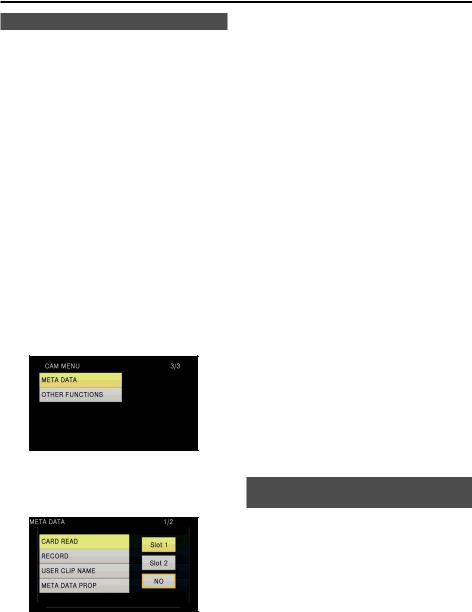
Uploading the metadata (META DATA)
You can perform any of the following operations. If necessary, make preparations prior to undertaking the operations.
Loading the metadata
• Insert the SD Memory Card on which the metadata is recorded into the unit. (For details on contents of the metadata, see the previous page.)
Selecting whether to record the metadata on the SD Memory Card
Initializing the metadata inside the unit Displaying the metadata inside the unit
1 Press the mode button and select CAM mode.
2 Press the MENU button.
Menu operation (Page 44 of Vol.1)
3 Tilt the lever in the 
 directions to select META DATA, and push the Operation lever (or tilt in the
directions to select META DATA, and push the Operation lever (or tilt in the  direction).
direction).
4 Tilt the Operation lever in the 
 directions to select item, and push the Operation lever.
directions to select item, and push the Operation lever.
CARD READ:
Read metadata set to the SD Memory Card with the camera.
Move to LOAD, push the Operation lever, select whether or not to read the metadata (YES/NO), and push the Operation lever again.
āā Up to 10 items of metadata on the SD |
|
Memory Card can be displayed, starting |
Shooting |
alphanumeric characters are used in the |
|
from the most recent date of production. |
|
āā If characters other than single-byte |
|
metadata file name to be loaded, they are |
|
|
|
displayed as “ ”. |
|
RECORD:
Select this to set whether to record the metadata to be loaded into the unit simultaneously on the SD Memory Card. Select ON to record the metadata or OFF to cancel the recording, and push the Operation lever. The factory setting for this mode is OFF.
USER CLIP NAME:
The USER CLIP NAME recording method is selectable. Please refer to the next column below.
META DATA PROP:
Select this to display the metadata which has been recorded in the unit.
CLIP COUNT RESET:
Reset the counter value to 1.
Select whether or not to reset (YES/NO), and push the Operation lever.
META INIT SET:
Select this to initialize the metadata which has been recorded in the unit.
Select YES to initialize the metadata or NO to cancel the initialization, and push the Operation lever.
5 Press the MENU button to release the menu mode.
Selecting the USER CLIP NAME recording method
Press the MENU button and select META DATA →
USER CLIP NAME to select the recording method. Two options are available: TYPE1 and TYPE2.
USER CLIP NAME to be recorded
|
TYPE1 |
TYPE2 |
|
|
|
|
|
If clip metadata has |
Uploaded |
Uploaded data |
|
+ COUNT |
|||
been read in |
data |
||
value |
|||
|
|
||
If no clip metadata |
|
|
|
has been read in |
Sequential 5- |
Sequential 5- |
|
or if the setting |
digit number, |
digit number, |
|
for recording clip |
in order of |
in order of |
|
metadata has been |
recording |
recording |
|
turned off |
|
|
23
